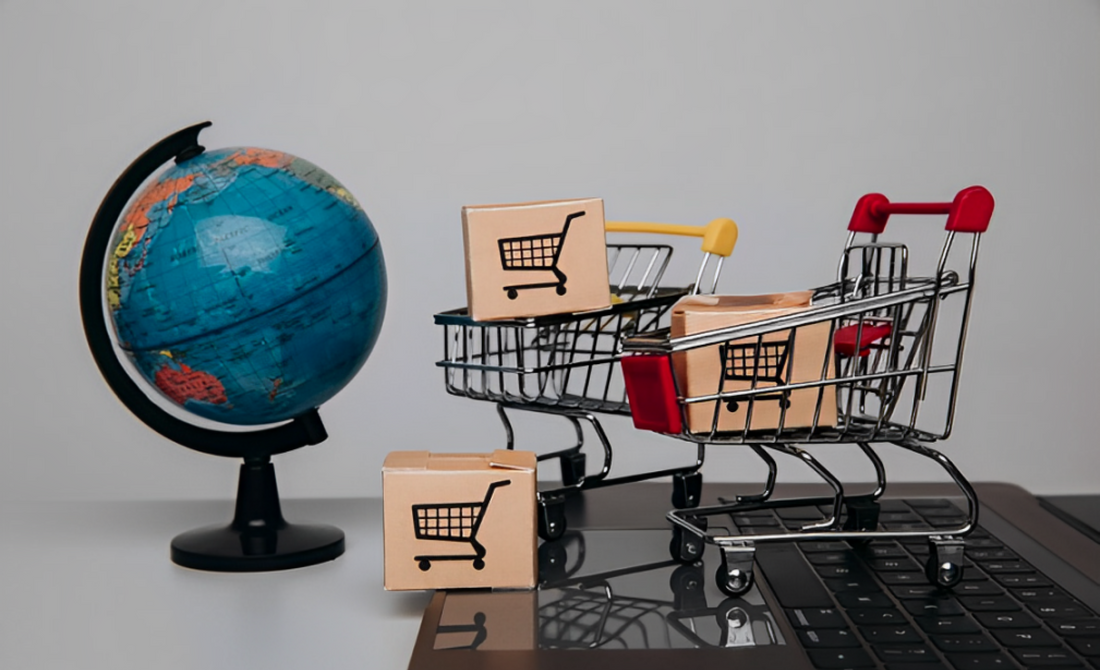A Guide To International Ecommerce In Shopify
e commerce
international e commerce
shopify

International ecommerce has become a crucial growth strategy for companies trying to reach a wider audience. This growth is not only feasible but also effective for Shopify store owners thanks to the platform's broad range of features that makes it easier to do cross-border selling.
Today, we will discuss the process of taking your Shopify ecommerce store on a global level including how to do initial preparation to smoothly manage international operations.
Why Take Your Shopify Store Into International Ecommerce?
There are many advantages to growing your online store into foreign markets. Even if your domestic market is doing well, expanding internationally gives you access to
- New markets
- Result in higher sales
- Creates more brand awareness
- Generates market leadership
Shopify’s robust features help ensure that your international transitions are as smooth as possible. Thus it helps to minimize risks while maximizing your reach.
But there are drawbacks to expanding internationally.
From understanding foreign markets to addressing legal regulations, expanding globally requires strategic planning. However, with the right approach and the tools that Shopify offers, this process becomes much more manageable.
But what is this approach that we are talking about? Let’s see.
Step 1: Determining The Right Time For International Expansion
The first important thing to ask is: Are you prepared to expand internationally? For many businesses, premature international growth can result in unnecessary complications.
Thus you need to take into account the following two crucial indicators to prevent errors:
Domestic Market Saturation: If your local market has become stagnant, increasing your company's global exposure can revive your growth strategy.
Organic International Interest: Examine your website's stats to see if there is an increase in foreign visitors. This signifies that there is a natural demand for your items since they are appealing to audiences overseas.
For instance, a fashion brand that sells expensive shoes may observe a consistent rise in traffic from European nations, indicating that it's time to think about shipping abroad. Once you identify these signs, the next steps will involve preparing both logistically and strategically for the new markets.
Step 2: Research and planning
Before you start making any changes to your Shopify store, it is essential that you gather all the necessary information needed for this transition. A thorough preparation helps you to avoid any unwanted risks and increase the likelihood of success.
Some key areas to explore include:
Identifying Potential Markets: Begin by using analytical tools offered by Shopify to access where your current international visitors are coming from. You can also look for regions that align with the kind of product that you are offering. For instance, if you are selling eco-friendly products, your focus should be more on European markets.
Understanding Legal and Regulatory Requirements: Every country has framed its own set of regulations, taxes, imports, and duties. For example, selling nutritional supplements can be highly regulated in one country but comparatively easy in another. Make sure that your product and regulations are adjusted per the law of the country you wish to target.
Competitor Analysis: Study your competition in target markets to understand how they position their products, price points, and marketing strategies. This knowledge will help you in identifying your unique selling points (USPs) and modifying your business plan to suit regional tastes.
Step 3: Optimizing Your Shopify Store for Global Markets
The next step after completing your research is to make your Shopify store more accessible to people throughout the world. This includes a number of adjustments that you might need to make to accommodate different languages, currencies, and shipping logistics.
Localizing Your Storefront
In simple terms, localization involves adjusting the content of your Shopify store as per the cultural and linguistic preferences of the new market. For example, if you’re expanding into France, you need to ensure your website supports French language options.
- Use Translation Apps: Shopify offers various translation apps such as Translate and Adapt or Langify. These tools can help you to automatically translate your pages, blog content, or product descriptions.
- Cultural Considerations: Localization goes beyond language - It includes knowledge of local values, design aesthetics, and cultural preferences. For example, changing key components, such as colors or symbols, can help gain the trust of new clients as they can be understood differently in other nations.
Setting Up Multi-Currency Options
For conversions, it is essential to give clients the choice to pay in their local currency. Shopify Payments reduces checkout hassle by enabling you to automatically convert prices based on the visitor's location. This feature is available on all Shopify plans, and the platform supports over 130 currencies.
- Real-time Currency Conversion: Shopify Payments makes sure that your prices are in accordance with current foreign exchange rates. Thus it allows your clients to pay in the currency of their choice without any problems.
- Transparent Pricing: By displaying prices in local currencies, buyers will feel more comfortable knowing exactly how much they are spending. This primarily helps in lowering your cart abandonment rates.
Shipping and Logistics
One of the largest obstacles to international ecommerce is shipping. Consumers anticipate prompt and reliable delivery, so meeting their needs effectively calls for meticulous planning. Here's how to efficiently handle your shipping:
- Carrier-calculated Shipping Rates: Shopify provides real-time shipping rates at checkout by integrating with key carriers like FedEx, UPS, and DHL. Shipping options include dynamic shipping dependent on the order's destination, free shipping for some areas, and flat-rate delivery.
- Shipping Zones and Profiles: Grouping nations into shipping zones with similar pricing will help you organise your logistics. This simplifies the procedure and gives clients clear shipping prices at the point of sale.
For example, if you sell tech gadgets and are shipping to both Europe and North America, you might establish separate shipping zones for each region with differing shipping fees.
Step 4: Leveraging Shopify’s International Features
Shopify provides a number of powerful tools to help you manage and scale your international ecommerce operations.
Shopify Markets
With the help of Shopify Markets, retailers can sell to several nations from a single Shopify store. It allows you to tailor the shopping experience according to the visitor's location by providing:
- Multiple Languages and Currencies: Local currencies and automatically translated content enhance the client experience.
- Calculations for tariffs and Taxes: Shopify Markets can compute and show local taxes and tariffs automatically at checkout, saving clients from unwanted surprises thus enhancing transparency.
Shopify Expansion Stores
Shopify Plus gives larger companies the ability to open extension stores. By setting up separate shopfronts for each region you want to target, expansion stores let you further customize your product offerings, content, and marketing tactics.
A beauty brand that wants to enter both Asia and Europe, for instance, can create distinct expansion stores for each market, each of which would be suited to the customs and shopping habits of those particular areas.
Step 5: Marketing Your Store Internationally
Translating your content alone is not enough for international marketing; you also need to create a message that appeals to a variety of consumers.
Localised Social Media Campaigns: Facebook, Instagram, TikTok, and other platforms allow targeting based on specific regions. Make your advertisements reflect popular culture, holidays, and local trends.
SEO for International Audiences: Ensure that the SEO of your website is tailored for users from around the world. Make sure your translated content contains location-specific keywords to increase its visibility in local search results.
A fashion merchant aiming to reach the German market, for example, would not only translate their content into German but also look up and inculcate keywords that German consumers frequently use while looking for clothing.
Step 6: Challenges of International Ecommerce
There are advantages to expanding internationally, but there are drawbacks as well:
Regulatory Compliance: Import and product laws vary from nation to nation. Although automated tax computation tools offered by Shopify can assist in handling these complexities, you must continue to keep up with changing legal requirements.
Cultural Sensitivity: Making mistakes might result from a lack of awareness of cultural standards. For example, a marketing effort that is successful in one market could be viewed as offensive or unsuitable in another.
Payment Methods: Various payment methods are preferred in different regions. To increase conversions, look into the preferences of your target market and consider implementing digital wallets, bank transfers, or cash-on-delivery options.
visit for more information : Find The Multiple Of Your Ecommerce Valuation
Conclusion
Expanding your Shopify store into international markets is an exciting opportunity for growth, but it requires careful planning and execution. You can accomplish global ecommerce by using the advanced features offered by Shopify through localizing your content, and providing multi-currency alternatives. With a strategic approach and a keen understanding of your target markets, you can successfully position your brand on the global stage, opening up new revenue streams and expanding your customer base.
CrawlApps
At CrawlApps, we don’t just build Shopify stores—we create experiences that sell. We’re a bunch of problem-solvers who love turning ideas into stores that actually converts. Whether it’s fixing what’s broken or building something from scratch, we make sure every detail works in your favor. No fluff, no jargon—just real solutions that help your business grow. If you’re serious about Shopify, you’ll feel right at home with us.















